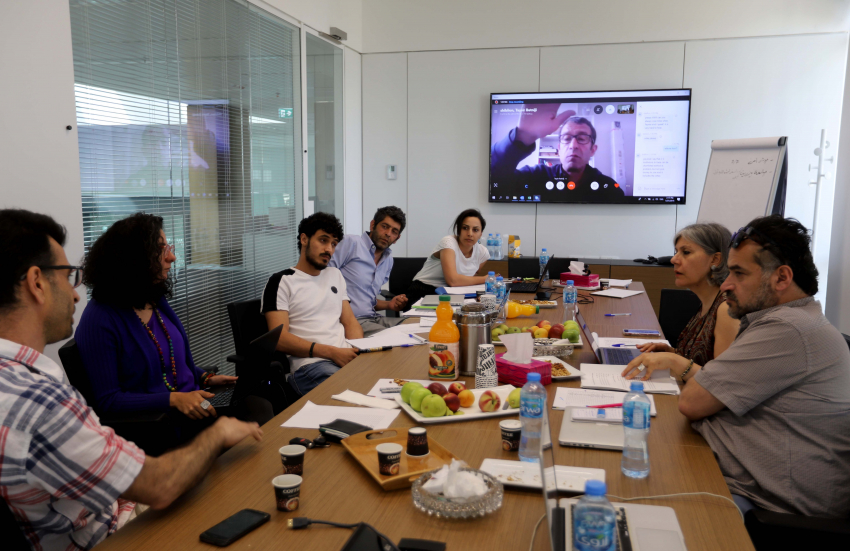
The A.M. Qattan Foundation (AMQF) recently released the preliminary shortlist of organisations that have qualified for the second round of the ‘Visual Art: A Flourishing Field’ (VAFF) project grants.
Twenty-eight cultural and arts organisations based in the West Bank, including Jerusalem, and the Gaza Strip applied for project grants following an open call that was published in local newspapers, AMQF’s website, and on social media platforms.
The applications were assessed by an independent jury of seven members. These included the artists Tayseer Al Batniji and Khaled Hourani, academic Alaa al-Azza, social activist and General Director of the Tishreen Association in Al Taybeh, Majd Nasrallah, and the Chairperson of the Advisory Committee of the Rawa Creative Communities Palestinian Fund, Fadya Salfiti. Writer and critic Adania Shibli and curator Samar Martha, members of the selection committee in the first round of the project, also participated in this second round in order to ensure the accumulation of experience.
Individual members of the jury made their own evaluations of the applications, before following this in the first selection committee meeting with a review of the evaluation criteria and a collective discussion and evaluation of the applications, including their strengths and weaknesses.
"The evaluation process created a rich opportunity for colleagues in the field of the visual arts and in cultural work in general to discuss the work of key organisations in Palestine and how they deal with the question of the visual arts," commented Shibli, who participated in the meetings via Skype from her home in Berlin. Shibli also added: “Although such discussions are common, they rarely take place to achieve constructive criticism, which sets in motion the process of overcoming some of the problems faced by the visual arts field. The preliminary results confirm this, and it is necessary to shed light on the need for pluralism in the form of practices in the visual arts, as well as expand and transform its meaning and bring awareness to necessary aspects within the field.”
Khaled Hourani commented: “The committee deemed that the initial shortlisted organisations have the priority to be awarded the grants in accordance with the criteria and the followed procedures, and noted that all the submitted applications are vital and important and addressed the critical and necessary needs for advancing the cultural project in Palestine. The grants focus on the visual arts and on the organisations working in the field in order to influence and have an impact on the visual arts scene and ensure its sustainability and development for the future. The committee considered these needs, the vitality of the organisations and their ability to implement the proposals effectively.”
After thirteen organisations convened to discuss their proposals, before reaching any final decisions the committee deliberated and agreed on the nomination of twelve organisations for the initial shortlist. The committee and each organisation will engage in an open dialogue on ways to develop the proposals that will be in line with the vision, capabilities and needs of the organisations. This, in turn, will ensure that the proposals correspond to the needs of the visual arts scene and enhance the sustainability and impact of the institution. The committee also emphasised that some proposals will require further fundamental and inherent development in order to ensure their continued participation within the competitive process.
The preliminary shortlisted institutions include: the General Union for Cultural Centres, Gaza; Gaza; Eltiqa’ group, Gaza (applying through the Palestinian Red Crescent Society in Gaza); the Palestinian Art Court-Al Hoash, Jerusalem; Dar Qandeel for Arts and Culture, Tulkarem; Sakiya: Art, Science, Agriculture, Ein Qiniya; the Visual Arts Forum, Ramallah; the Khalil Sakakini Cultural Centre, Ramallah; Birzeit University, Birzeit; Dar Jacir, Bethlehem (applying through Al Rowwad Cultural and Arts Society, Aida Refugee Camp); Dar Al Kalima University College of Arts and Culture, Bethlehem; the Palestinian Museum, Birzeit; the Wonder Cabinet, Bethlehem.
The inclusion of any organisation in this initial list does not necessarily indicate that it will automatically receive the grant. It is, however, a recognition of eligibility to take part in the next phase of the evaluation, according to which, as stated in the call for applications for the VAFF project grants, the administrative and financial capacities of the organisations as well as their developmental needs will be assessed. The committee and the VAFF project team will conclude discussions with each organisation, with the objective of developing their submitted applications.
The financial resources dedicated to the second round of the VAFF project grants amount to a sum of around US$1.6 million. This determines the number of organisations that can be supported and the size of the financial contribution, which will be prompted by the proposed needs and the ability of the organisation to manage the grant effectively.
Following the first phase of evaluation, Yara Odeh, VAFF Project Manager, commented, “We thank all the organisations that applied for the VAFF grants, and hope that the proposals that will be supported during this round will increase the potential for cooperation between art, academic and cultural organisations, and offer opportunities for artists, researchers and visual arts professionals in particular, in order to promote the field of visual arts in Palestine.”
The VAFF Project aims to strengthen the capacity and sustainability of visual arts organisations, to develop their learning programmes and research opportunities, to enable cultural and art organisations to support art students, artists and professionals in the field, and to expand the audience for the visual arts in Palestine.
